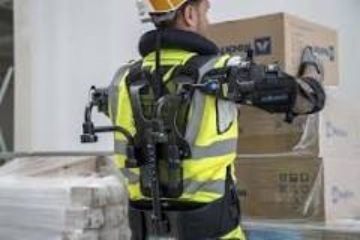Harnessing the Power of Exoskeletons

In the dynamic landscape of smart buildings and infrastructure, technological advancements continue to redefine the way we design, construct, and operate our built environments. Among the most groundbreaking innovations are exoskeletons — wearable robotic devices that augment human capabilities and enhance productivity.
Exoskeletons represent a paradigm shift in how we interact with our surroundings, empowering individuals to overcome physical limitations and perform tasks with greater ease and efficiency. Designed to support and enhance human movement, exoskeletons provide users with increased strength, endurance, and ergonomic support, making them invaluable assets in various industries, including construction, manufacturing, and logistics.
Enhancing Safety and Ergonomics in the Workplace
One of the primary advantages of exoskeletons lies in their ability to improve workplace safety and ergonomics. By reducing the risk of musculoskeletal injuries and fatigue-related accidents, exoskeletons help create safer and more conducive working environments for employees. In smart buildings and infrastructure projects, where the demand for efficiency and precision is paramount, the integration of exoskeletons can significantly enhance productivity while mitigating occupational hazards.
Optimizing Performance and Efficiency
Exoskeletons play a crucial role in optimizing performance and efficiency across diverse sectors. In construction and infrastructure development, where labor-intensive tasks are commonplace, exoskeletons enable workers to lift heavy objects, maintain proper posture, and reduce physical strain during prolonged periods of activity. This not only improves productivity but also minimizes downtime and accelerates project timelines, ultimately driving cost savings and project success.
Streamlining Operations and Maintenance
Beyond their applications in construction, exoskeletons offer compelling benefits for operations and maintenance within smart buildings and infrastructure. From facility management to utility maintenance, exoskeletons enable workers to navigate complex environments, access elevated areas, and perform routine tasks with greater agility and precision.
In conclusion, exoskeletons represent a transformative force in the realm of smart buildings and infrastructure, offering professionals a powerful tool to augment human capabilities and optimize performance.
Latest insights & stories

Wat is 5G-slicing en wat betekent het voor uw business?
De troeven van het 5G-netwerk op het vlak van snelheid, bandbreedte en lagere latentie zijn intussen bekend. Een ander, even essentieel kenmerk blijft evenwel vaak onderbelicht: network slicing. Tania Defraine, Director Enterprise Solutions & Platforms bij Proximus NXT, legt uit hoe het opdelen van het mobiele netwerk in aparte schijven resulteert in een maximale bedrijfszekerheid, flexibiliteit en kostenefficiëntie.

Internet of Facades (IoF) is koploper in het tijdperk van slim en duurzaam wonen: Living Tomorrow showcased IoF
Terwijl de wereld zich snel beweegt naar een meer verbonden en intelligente toekomst, evolueren de gebouwen waarin we leven en werken fundamenteel. Een van de meer ingrijpende evoluties in het architecturale landschap is de transmutatie van traditionele gevels naar dynamische, responsieve entiteiten, via het concept van het Internet der Gevels (IoF). Deze integratieve aanpak wijst op een revolutie in het beheer en onderhoud van gebouwen, leidend tot een tijdperk van duurzaam en slim wonen.

Luxe hergedefinieerd: ontdek de kracht van zacht water
Of het nu voor vakantie, werk, een congres of wat voor reden dan ook is, veel mensen over de hele wereld reizen en verblijven in verschillende accommodaties. Hoe denk je dat dit in de toekomst zal zijn?